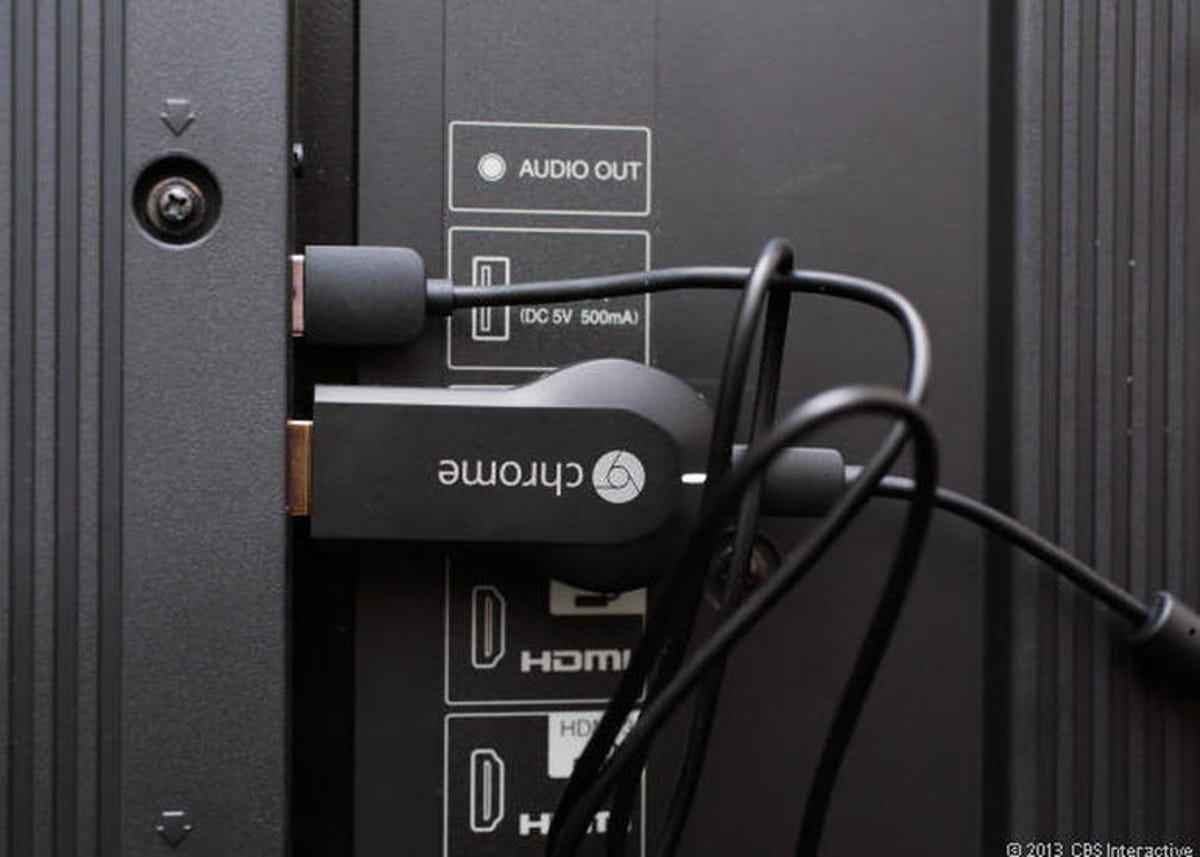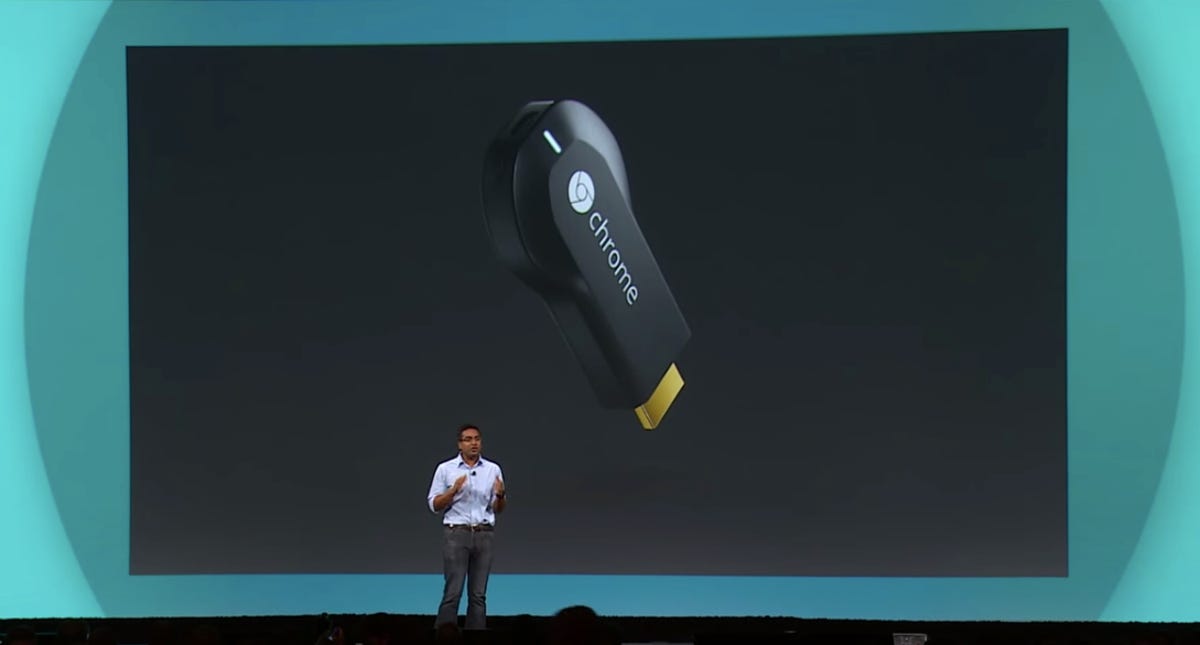
Sarah Tew/CNET
Google’s Chromecast was a break-out hit in what was the niche category of streaming media dongles because it went after what mattered to consumers: low price tag.
The Chromecast wasn’t the first wireless streaming-media dongle to come along — Roku had one long before — but the $35 price and the initial offer of three months of free Netflix sparked a flurry of interest. The Netflix promotion sold out in four hours on Amazon and 24 hours on Google Play, and the Chromecast itself was out of stock online within two days. Even now, the Chromecast remains on top of Amazon’s electronics best-seller list.
While Chromecast’s runaway sales leave no doubt about its popularity in stores, some suggest that it may not translate to popularity in the living room. A study by market researcher Parks Associates last month found Chromecast usage appeared to be slipping.
Having crossed the one-year anniversary of its launch last week, Rishi Chandra, director of product management for Chromecast, spoke with CNET about the early days of Chromecast’s development, his team’s celebration when the curtain rose (tequila shots were involved), and what’s to come. The following is an edited Q&A.


Screenshot by Joan E. Solsman/CNET
Q: Up to the launch last July, talk about what it took to get Chromecast to the unveiling. Chandra: We had a small team with this great idea built around using your mobile device. But we had a variety of challenges.
The first was: what if we assumed you would have this great YouTube or Netflix experience on your phone, and just one button — that’s all it takes — just one button and you send it to the TV? How do we convince the content industry that this is the way forward? That’s why we partnered with YouTube internally and with Netflix. If we can prove it with Netflix and YouTube, we could prove it with any type of content.
The second challenge was: how do we bring this in an affordable way to the consumer? One of our key design principles was the device should just hide behind the TV but still have all the Wi-Fi capabilities you need. We spent a lot of time tuning and adjusting Wi-Fi and getting the price of the device down so we could make it really affordable to consumers.
Q: With all the indications of huge demand after Chromecast launched, did you have any idea beforehand about what you were unleashing? Chandra: That first day, I remember we finished the announcement and we all went to lunch right after to celebrate. At that point was when Amazon told us they had run out inventory already, and they wanted to buy more. It wasn’t a very long gap between the time announced to the time where we’re like ‘Oh my god, we have to ramp this up.’ Demand was much higher than even we thought or Amazon thought or Best Buy thought. So it was a fairly short-lived celebration. We were in San Francisco, in the Dogpatch [a transitional neighborhood south of downtown], it was some Mexican restaurant near the Dogpatch, I forget–we had tequila shots, that’s all I remember.
Q: Well, that’s how it usually goes when there are tequila shots involved. Chandra: We were the only ones in there, and it was the 30 members of the team who got the privilege of coming up to the event. The rest of the team was enjoying drinks down here [at Google’s headquarters in Mountain View, Calif.]
Q: After that initial whiz-bang, fireworks moment of unveiling, talk about Chromecast in its second stage. Chandra: When we launched the product, we always thought this was the beginning of something new. We started with four apps, but our goal was to bring the simplicity of the model to every app you have on your phone, your tablet or your laptop. We have done a very good job getting more and more content partners, in terms of every few weeks, every month, we’re bringing in more Chromecast support.
Related links:
- Google’s $35 streamer inches on, not past Roku
- Google’s Chromecast: Holding market share, losing viewers
- With Android TV, Google takes third shot at television
- A birthday gift from Chromecast: $30 of unlimited music
- Chromecast: Google’s best weapon to breach the TV biz
The second dimension, which is important for a company like Google, is we have to be global. Starting in the first quarter, we were able to launch in now 20 different countries. What I’ve been happy with is we have been able to replicate that success we had in the US. In Japan, we had people lining up out the door of Japan retailers trying to find the product.
The third dimension is how do we start making use of this multiscreen experience that allows you to do things you just couldn’t do before. At Google I/O (the company’s annual developer conference), we announced some of the initiatives: make it even easier to have all your content on your mobile device get displayed to the television, so we launched Android Mirroring. Then there’s the “backdrop” feature: what if we personalize a feed of images on your TV and allow people to use their phone to find out more? And we want to make it easier for others to cast to your TV without using your WiFi password.
Going forward we’ll continue to invest in those three dimensions. There’s a bunch of other things that we didn’t announce at I/O.
Q: If you drop a little crumb like that, I’m going to ask: What wasn’t talked about at I/O? Chandra: I wish I could say. Nope. Got to keep some of the excitement alive.
Q: One thing that was announced at I/O was Android TV. How does Chromecast coexist with Android TV? Chandra: I definitely believe they’re complementary. Chromecast is really about Google Cast, technology that allows these mobile screens to work together. Android TV, the goal there is to solve a different problem. There are a bunch of devices already — televisions, set-top boxes, gaming consoles — and Android TV is looking to bring a platform where we can standardize similar to what Android has done in the mobile and the tablet space.
From my standpoint, I love it; we’re getting wider distribution for the Cast model.


Screenshot by Joan E. Solsman/CNET
Q: Do you have any aggregate usage figures to rebut the Parks study and anecdotes that Chromecast owners try it but then let the device sit unused? Chandra: We track engagement of a seven-day-active user and a 28-day-active user, and we shared the seven-day number at I/O: We’ve seen minutes spent increase by 40 percent since Oct. 1. [In other words, the minutes of usage per device among people who use Chromecast at least one a week is up 40 percent.] Now, we are a price point that is lower. It’s an impulse buy, and people are trying it out. But the fact that we are seeing usage increase at that level is proof that people aren’t just trying it out once and then dumping it.
Online consumption still pales in comparison to live TV. There is a very big pie to go after. It’s a challenge for the entire industry to make sure streaming devices continue to grab attention of users, get more and more content, and build greater experiences.




